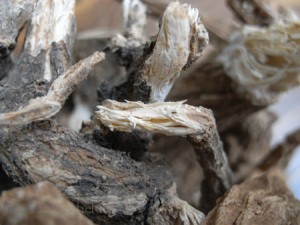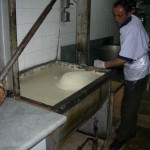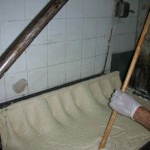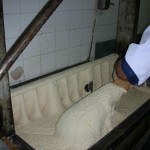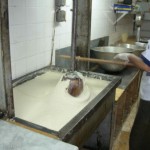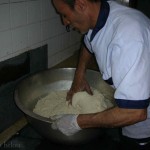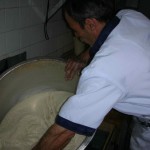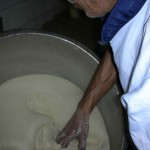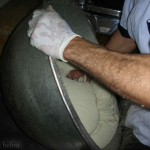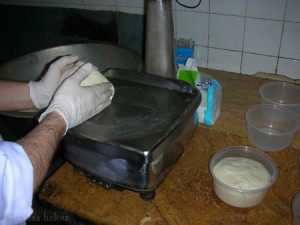29 Sep
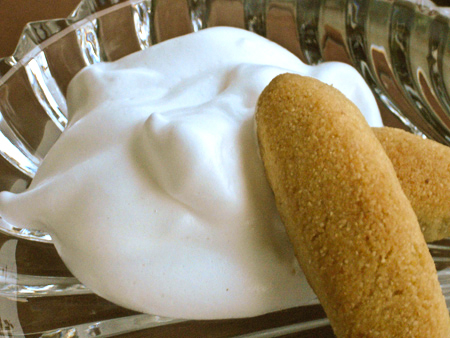
Long before the wonderful Alan Davidson died, I embarked, together with Helen Saberi and Esteban Pombo Villar, on the most marvellous adventure under Alan’s aegis, trying to elucidate the mysteries of natef, a white soft meringue-like dip made with an unlikely ingredient (dessicated roots that look like dead wood) which is served with karabij Halab (semolina cookies filled with either pistachios in Lebanon or walnuts in Aleppo).
I was writing Lebanese Cuisine then and I had brought some of the root with me from Beirut to test the recipe but I had two conflicting bits of information regarding the root which is known as shirsh el-halaweh in Arabic. Some people refer to it as ‘erq al-halaweh. Claudia Roden describes it as bois de Panama in her Middle Eastern cookbook and the late Ibrahim Mouzannar, one of my favourite authors on Lebanese food, has it as soapwort in his Lebanese cookbook. You can actually read the full investigation of our Interspi (spi for spices) in the Wilder Shores of Gastronomy or in PPC. I will not repeat the information here but I will show you in pictures how natef is made, just in case you can get some and want to experiment. I, for one, am hoping that Australian customs will let me bring in my 1 ½ kilograms of shirsh el-halaweh for my demonstration of natef & karabij during the World Chef Showcase programme in Sydney on 10 October. Read more >
23 Sep
Everyone knows and loves halva. Well, perhaps not everyone loves halva but most people know it, the tahini one that is. Still, despite halva being fairly common now, few people know how it’s made. And I have to admit that I didn’t except for the one time, many many years ago, when I made it following a recipe from Leslie Kenton’s Raw Energy, and after I nearly broke my food processor trying to grind the sesame seeds, I ended up with a halva that bore no resemblance to any I ever had — there are other types of halva but more on that in future posts. In any case, it wasn’t until a few years ago that I finally saw halva being made, and what a revelation that was. I was being taken round the old souks of Aleppo by a wonderful character and a friend now, Hassan Khoja who is the burly man in the first video below, when we stopped at the shop of a friend of his, Omar Akesh, who sells tahini and halva which he produces in a sprawling and rather medieval space behind and above his shop. The only thing I knew then was that shirsh al-halaweh (meaning the root or vein of sweetness in Arabic, or plain soapwort root in English) was used in the making of halva (it is listed as one of the ingredients) although I wasn’t quite sure how. So here is what I found out.
[vimeo]http://www.vimeo.com/6714556[/vimeo]
First you need tahini, and to make tahini, sesame seeds have to be roasted, soaked, hulled and pressed, all of which are done by Omar’s men in the upstairs room. Then the soapwort roots have to be boiled to produce a brown liquid which when beaten miraculously turns into a brilliant white foam (because of the saponin). This foam is then mixed with sugar syrup to produce a meringue-like dip called natef, which is also served with karabij halab, a crumbly ‘cookie’ filled with pistachio nuts. In fact, the natef that goes with the karabij is slighly different from the natef that is used in halva but I can’t remember the proportions now — somewhere I have notes telling me the ratios. The natef is made in a kind of tin machine/beater (sadly the only part of the process which I didn’t manage to photograph or film) and once it’s ready, it is mixed with the tahini. The mixture is then processed in three different stages. First it is churned as you can see in the video above. Once the halva maker judges it ready to be beaten, he attaches a huge wooden pestle to an automated arm which will drop it into and lift it from the mixture at a regular pace, while he goes on scraping the halva from the sides and pestle to ensure perfect blending.
[vimeo]http://vimeo.com/6714660[/vimeo]
And now comes the final stage, which is the kneading of the halva. The mixture is transferred into a beautiful large metal bowl with a round bottom so that it can be rocked back and forth, and the halva maker kneads the mixture until it is smooth before portioning it out and packing it in plastic boxes.
[vimeo]http://www.vimeo.com/6714805[/vimeo]
At Omar Akesh, and elsewhere, you can buy halva plain, or you can choose the more expensive version with pistachio nuts. The nuts are usually pressed on the outside of the halva cake but there is a more luxurious version with more pistachio nuts that are kneaded into the mixture. Here is a close-up of soapwort as well as a few shots of the sequence of events in the making of halva.
